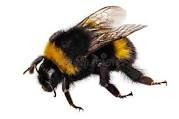Swarms
Bumble bee Wasp Honey bee
Honey bees swarm as a means of creating a new colony and this usually happens as the number of bees in the hive increases. This normally occurs during May and June.
Honey bees are struggling at the moment and wild populations are getting fewer and fewer and domesticated honey bees are not having an easy time either. As a consequence all swarms are very precious and every effort should be made to find a suitable home for them.
What to do if you find a swarm
First: Please establish that it is a swarm of honey bees. A lot of our time is taken up with calls for help in sorting out bumble bees. If the cluster (swarm) bees don't look anything like the 2 photographs above and the bees are disappearing into a hole and are big, black and fluffy then we can not do anything to help you. They are Bumble bees and harmless and doing an incredible amount of good for the environment and should be enjoyed.
If you should happen to come across a swarm of honey bees they are usually quite docile. To be on the safe side though keep children and pets well away so the bees are not disturbed and then immediately telephone a beekeeper. (See below.)
If you know a beekeeper in your locality please try and contact them as the swarm may be their bees, otherwise contact your local Association. This Association can only provide help for swarms reported on the Black Isle, west through Strathpeffer and Contin and east through to Invergordon. There are Associations based in Inverness and Tain who will cover their own areas.
Once you have established that they are honey bees and are in our area, please call one of the following people with a location, your contact details and ideally a few photos of the swarm to show how accessible it is to reach.
Barbara Gray 0774 8932231 (association Secretary)
Angie Dunn, 07732 587084 (Association President)
The following members can also be contacted to collect swarms:
Eilidh Hunter 0770 3639849
Mark Fraser 07538144947
David Edes 07860524394
Caroline MacKenzie 07972714388
Andrew Card (Loch Ness Honey) 07796952908
Don Fraser 07716 677617
Pravin Whiles 07970204035
If you have difficulty in contacting us, the police or the Environmental Health Department may have a comprehensive list. Beekeepers may ask for a small fee to cover the costs involved.
The Scottish Beekeepers web site has more information SBA Web Site
The story to go with the pictures in the Gallery at the foot of the page.
I was sitting reading the paper and heard a lot of noise in the yard, went out and it was full of bees - settling on the house, the cars, but focussing on the wooden horse and garden shed. I shut the door(!) and watched from inside, and within 10 minutes they had all landed on and around the wooden horse.
After pondering the best way to pick them up (not an easy knock-into-a-box job) I decided to try the skep. So I sat the skep on the horse's head and hoped for the best. But of course they didn't go up.
I fetched the smoker and tried that - it was like herding cats! But in the end they started to move slowly up towards the skep...and then out around the sides! So then my smoking was a mixture of below to encourage them up, then above and to the sides to marshall them back down again! After about 40 minutes of smoking they were finally pretty much in, so I left them in peace to reorganise themselves.
At 10 o clock at night, when it was cool and the light was fading, I went back out armed with the wheelie bin and a nuc box, and lifted the skep off. Most were in it, but some were still on the wooden horse's head. Pondered for a while, then leant the skep on the shed, and swept the ones on the horse into the nuc with 80% success. Good start!
I put the nuc on the wheelie bin (which was the same height as the wooden horse so I thought that might help them find 'home'), picked up the skep and dropped them in. Pretty successful, most stayed in but there was the usual surge of bees upwards. Jammed the roof on quickly and watched - as they went under the nuc and clustered on the open mesh floor! Argh! Re-think time; went to find a doorstep for the nuc to stop them going underneath, then using said doorstep (piece of wood) scooped them up from underneath, put the doorstep on, and watched with great satisfaction as they went in! Repeat of that process several times and we were down to a handful flying. Left them to it, perched on the wheelie bin!
At 11 o clock, armed with breeze blocks and wheelbarrow, off I went again, shut their door, and moved them round to the patio. Bingo!
With thanks to Jane T.









